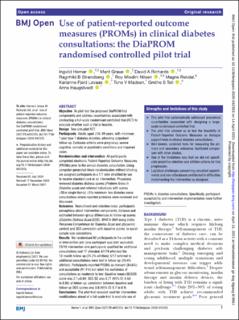| dc.contributor.author | Hernar, Ingvild | |
| dc.contributor.author | Graue, Marit | |
| dc.contributor.author | Richards, David A | |
| dc.contributor.author | Strandberg, Ragnhild Bjarkøy | |
| dc.contributor.author | Nilsen, Roy Miodini | |
| dc.contributor.author | Rekdal, Magne | |
| dc.contributor.author | Løvaas, Karianne Fjeld | |
| dc.contributor.author | Madsen, Tone Vonheim | |
| dc.contributor.author | Tell, Grethe Seppola | |
| dc.contributor.author | Haugstvedt, Anne | |
| dc.date.accessioned | 2021-04-23T09:20:33Z | |
| dc.date.available | 2021-04-23T09:20:33Z | |
| dc.date.created | 2021-04-20T14:12:12Z | |
| dc.date.issued | 2021 | |
| dc.identifier.citation | Hernar, I., Graue, M., Richards, D. A., Strandberg, R. B., Nilsen, R. M., Rekdal, M., Løvaas, K. F., Madsen, T. V., Tell, G. S., & Haugstvedt, A. (2021). Use of patient-reported outcome measures (PROMs) in clinical diabetes consultations: the DiaPROM randomised controlled pilot trial. BMJ Open, 11(4). | en_US |
| dc.identifier.issn | 2044-6055 | |
| dc.identifier.uri | https://hdl.handle.net/11250/2739299 | |
| dc.description.abstract | Objective To pilot test the proposed DiaPROM trial components and address uncertainties associated with conducting a full-scale randomised controlled trial (RCT) to evaluate whether such a trial is feasible.
Design Two-arm pilot RCT.
Participants Adults aged ≥18–39 years, with minimum 1 year type 1 diabetes duration, attending outpatient follow-up. Exclusion criteria were pregnancy, severe cognitive, somatic or psychiatric conditions and impaired vision.
Randomisation and intervention All participants completed electronic Patient-Reported Outcome Measures (PROMs) prior to the annual diabetes consultation. Using computer-generated block-randomisation without blinding, we assigned participants in a 1:1 ratio stratified by sex to receive standard care or an intervention. Physicians reviewed diabetes distress scores (Problem Areas In Diabetes scale) and referred individuals with scores ≥30 or single item(s) ≥3 to minimum two diabetes nurse consultations where reported problems were reviewed and discussed.
Outcomes Recruitment and retention rates; participants perceptions about intervention components. Variance and estimated between-group differences in follow-up scores (Diabetes Distress Scale (DDS), WHO 5-Well-being Index, Perceived Competence for Diabetes Scale and glycaemic control) and DDS correlation with baseline scores, to assist sample size calculations.
Results We randomised 80 participants to the control or intervention arm (one participant was later excluded). 23/39 intervention arm participants qualified for additional consultations and 17 attended. 67/79 attended the 12-month follow-up (15.2% attrition); 5/17 referred to additional consultations were lost to follow-up (29.4% attrition). Participants reported PROMs as relevant (84.6%) and acceptable (97.4%) but rated the usefulness of consultations as moderate to low. Baseline mean±SD DDS score was 2.1±0.69; DDS SD was 0.71 (95% CI: 0.60 to 0.86) at follow-up; correlation between baseline and follow-up DDS scores was 0.8 (95% CI: 0.7 to 0.9).
Conclusions The pilot trial revealed need for intervention modifications ahead of a full-scale trial to evaluate use of PROMs in diabetes consultations. Specifically, participant acceptability and intervention implementation need further investigation. | en_US |
| dc.language.iso | eng | en_US |
| dc.publisher | BMJ Publishing Group | en_US |
| dc.rights | Navngivelse-Ikkekommersiell 4.0 Internasjonal | * |
| dc.rights.uri | http://creativecommons.org/licenses/by-nc/4.0/deed.no | * |
| dc.subject | Diabetes støtte til egenmestring | en_US |
| dc.subject | Diabetes self-mangement support | en_US |
| dc.subject | Diabetes | en_US |
| dc.subject | Diabetes | en_US |
| dc.title | Use of patient-reported outcome measures (PROMs) in clinical diabetes consultations: the DiaPROM randomised controlled pilot trial | en_US |
| dc.type | Peer reviewed | en_US |
| dc.type | Journal article | en_US |
| dc.description.version | publishedVersion | en_US |
| dc.rights.holder | © Author(s) (or their employer(s)) 2021 | en_US |
| dc.subject.nsi | VDP::Endokrinologi: 774 | en_US |
| dc.subject.nsi | VDP::Endocrinology: 774 | en_US |
| dc.subject.nsi | VDP::Endokrinologi: 774 | en_US |
| dc.subject.nsi | VDP::Endocrinology: 774 | en_US |
| dc.source.volume | 11 | en_US |
| dc.source.journal | BMJ Open | en_US |
| dc.identifier.doi | 10.1136/bmjopen-2020-042353 | |
| dc.identifier.cristin | 1905337 | |
| cristin.ispublished | true | |
| cristin.fulltext | original | |
| cristin.qualitycode | 1 | |

